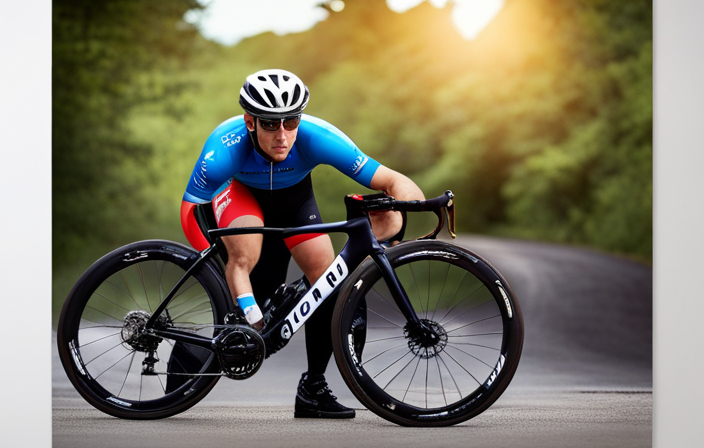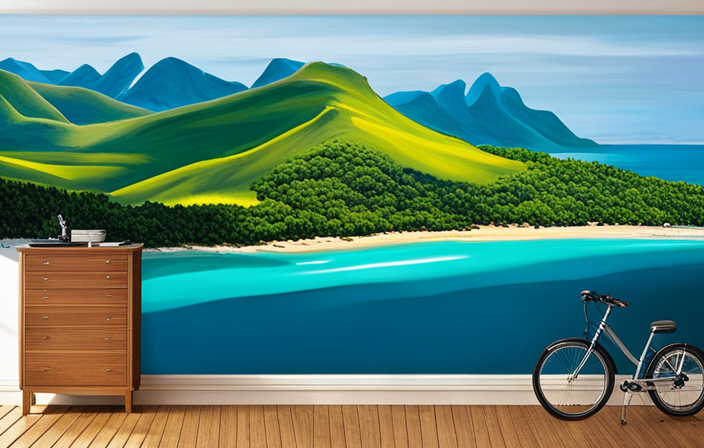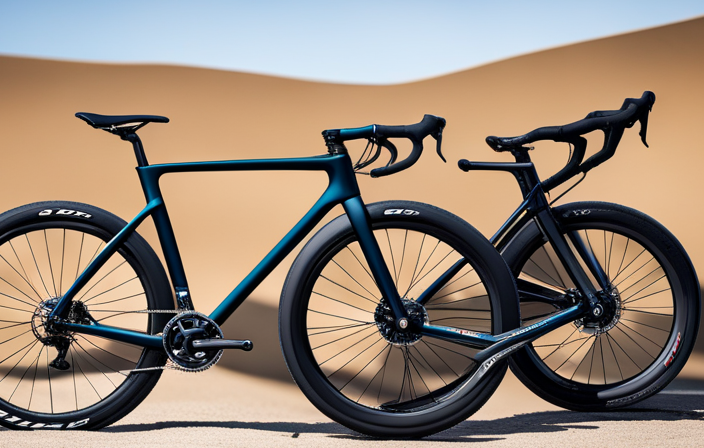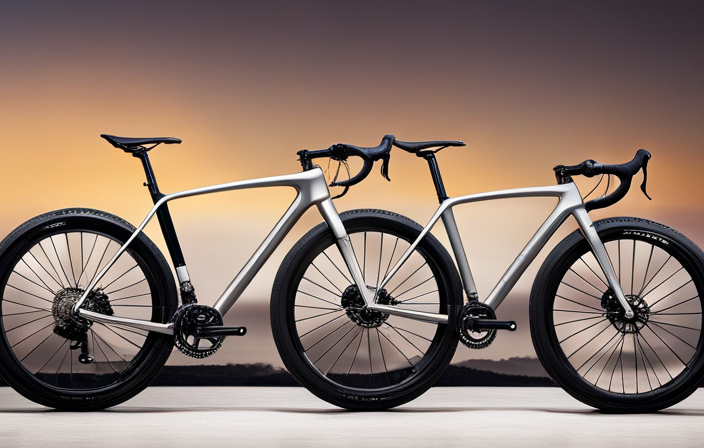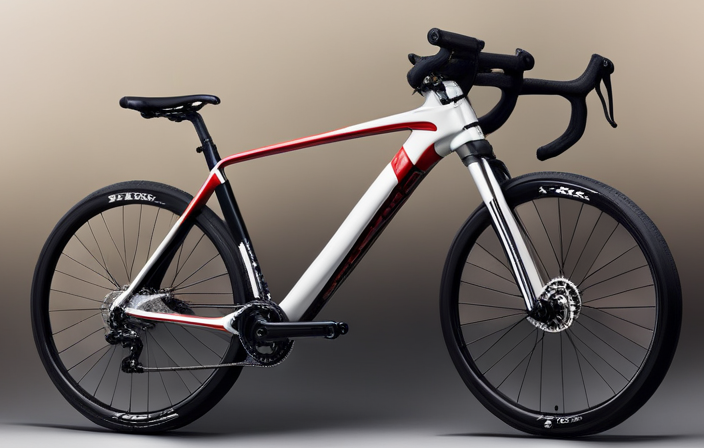Cruising down the curvy gravel trails, the crunch of stones sings a rugged tune. Each jiggle and sharp turn cranks up the excitement of exploring on my reliable gravel bike. Yet, even with the adrenaline pumping, I’m aware that having the right gear matters a ton for both comfort and safety during these wild rides.
So, let’s dive into the essential gear that will not only protect us but also enhance our experience on these rugged terrains. From cycling jerseys to knee pads, we’ll explore what to wear on a gravel bike journey like true explorers of the untamed path.
Key Takeaways
- Choose high-quality and reputable brands for cycling clothing, shoes, and accessories to ensure durability, performance, and comfort.
- Prioritize safety by wearing a properly fitting helmet that meets safety standards and incorporates MIPS technology for enhanced head protection.
- Invest in reflective gear such as vests, jackets, and accessories to increase visibility and ensure safety while gravel biking.
- Opt for padded shorts and knee/elbow pads to enhance comfort, reduce discomfort and chafing, and provide safety on rough terrains.
Cycling Jersey
You should wear a cycling jersey on your gravel bike ride. A good cycling jersey can make all the difference in keeping you comfortable and cool during your ride. When it comes to fabric types, there are a few options to consider.
One popular choice is polyester, which is lightweight and breathable, allowing for moisture wicking to keep you dry. Another option is merino wool, known for its natural temperature regulation properties and odor resistance. As for brands, some of the best ones out there include Rapha, Castelli, and Pearl Izumi. These brands are known for their high-quality materials and excellent fit.
When choosing a cycling jersey, it’s important to consider factors such as fit, breathability, and durability. Look for jerseys that have a snug but not restrictive fit to minimize wind drag. Breathable fabrics will help regulate your body temperature by allowing air circulation while also wicking away sweat. Durability is key since gravel rides can be rough on clothing with all the dust and debris.
Now let’s move on to cycling shorts…
Cycling Shorts
When cycling on rough terrain, it’s important to consider the comfort and support provided by your cycling shorts. The right pair can make a world of difference in your riding experience. Cycling shorts come in various materials, each offering its own set of benefits. For gravel biking, I recommend choosing shorts made from durable fabrics like nylon or polyester blends. These materials are designed to withstand the rigors of off-road riding while providing breathability and moisture-wicking properties.
One key feature to look for in cycling shorts is chamois padding. This cushioned insert provides extra comfort and protection during long rides on bumpy surfaces. It helps reduce friction and absorbs shock, preventing chafing and soreness in sensitive areas. When selecting a pair of shorts, ensure that the chamois padding is strategically placed for maximum coverage where you need it most.
To help you visualize the options available, here’s a handy table:
| Material | Benefits |
|---|---|
| Nylon | Durable, abrasion-resistant |
| Polyester blend | Breathable, moisture-wicking |
| Chamois padding | Provides comfort and protection |
As we transition into discussing cycling shoes, it’s important to remember that finding the right gear is crucial for an enjoyable gravel biking experience.
Cycling Shoes
For optimal performance, it’s essential to have the right footwear for your cycling adventures. Cycling shoes are specifically designed to enhance power transfer and provide comfort during long rides. Here are four key factors to consider when choosing the perfect pair:
-
Brand: There are several reputable cycling shoe brands in the market, such as Shimano, Sidi, Giro, and Specialized. These brands offer a wide range of styles and features to cater to different riding preferences.
-
Fit: Proper fit is crucial for cycling shoes. They should be snug but not too tight, allowing for efficient pedaling while preventing discomfort or hot spots. It’s recommended to try on multiple sizes and models before making a final decision.
-
Clipless Pedals: One of the major benefits of cycling shoes is their compatibility with clipless pedals. This system allows you to securely connect your feet to the pedals, maximizing power transfer and efficiency.
-
Cleat Compatibility: Different cycling shoe brands use various cleat systems like SPD-SL or Look Keo. Ensure that your chosen shoes are compatible with your pedal system for seamless integration.
Now that we have covered the important aspects of cycling shoes, let’s move on to another critical gear item – helmets – ensuring safety on every ride without compromising style or comfort.
Helmet
To protect your head while cycling, it’s important to choose a helmet that provides both style and comfort. Helmet safety should always be the top priority when selecting a helmet for your gravel bike adventures. A good quality helmet will not only keep you safe in case of a fall or collision but will also enhance your overall riding experience.
When it comes to helmet safety, there are a few key factors to consider. First and foremost, look for a helmet that meets the necessary safety standards such as CPSC or ASTM certifications. These certifications ensure that the helmet has passed rigorous testing and will provide adequate protection in the event of an accident. Additionally, consider helmets with MIPS technology, which helps reduce rotational forces on the brain during an impact.
Equally important is finding a helmet that fits properly. A well-fitting helmet should sit level on your head, with the front edge just above your eyebrows. It should feel snug but not too tight, with no pressure points or gaps between the padding and your head.
Incorporating these keywords: Helmet safety and Helmet fit, choosing the right helmet for your gravel bike adventures is essential for both style and comfort. Once you’ve found the perfect helmet, you can move on to another crucial piece of gear – sunglasses – to protect your eyes from debris and UV rays without compromising visibility on rough terrains.
Sunglasses
Sunglasses are an important accessory for protecting your eyes from debris and UV rays while enhancing visibility on rough terrains. When it comes to choosing sunglasses for gravel biking, there are a few key factors to consider. Here are three important aspects to keep in mind:
-
Lens options: Opting for sunglasses with interchangeable lenses is a smart choice. This allows you to adapt to different lighting conditions effortlessly. Clear lenses are perfect for low-light or overcast days, while tinted lenses can reduce glare on sunny rides. Polarized lenses are also worth considering as they minimize reflections and provide better visual clarity.
-
Prescription options: If you wear prescription glasses, fear not! Many sunglasses brands offer prescription lens options that can be tailored specifically to your needs. This ensures that you can enjoy clear vision without compromising on style or protection.
-
Fit and comfort: A proper fit is crucial for long rides on bumpy terrain. Look for sunglasses with adjustable nose pads and temple arms that provide a secure yet comfortable grip. Additionally, lightweight materials like polycarbonate frames help prevent discomfort during extended periods of wear.
Now that we’ve covered the importance of sunglasses, let’s move on to another essential piece of gear – gloves…
Gloves
Gloves provide added comfort and protection for your hands while riding on rough terrains. When it comes to choosing the right gloves for gravel biking, there are a few factors to consider.
First, let’s talk about glove materials. Look for gloves that are made from durable and breathable materials such as synthetic leather or mesh fabric. These materials not only offer excellent grip but also enhance ventilation to keep your hands cool during long rides.
Another important consideration is glove sizing. It’s crucial to find gloves that fit snugly without being too tight or too loose. Ill-fitting gloves can cause discomfort and affect your grip on the handlebars. To determine your glove size, measure the circumference of your hand just below the knuckles, excluding the thumb. Then, refer to the manufacturer’s sizing chart to find the perfect fit.
Finding the right pair of gloves can make a significant difference in your overall riding experience. They protect against blisters, reduce fatigue caused by vibrations on uneven surfaces, and offer an extra layer of insulation during colder rides.
Now that we’ve covered gloves, let’s move on to arm and leg warmers – essential accessories that will keep you comfortable in changing weather conditions without compromising flexibility or style.
Arm and Leg Warmers
Arm and leg warmers are versatile accessories that provide additional warmth and protection while riding in fluctuating weather conditions. They are a must-have for any gravel cyclist looking to stay comfortable on long rides.
Here are some discussion ideas to consider when choosing arm and leg warmers:
-
Layering options: Arm and leg warmers can be easily added or removed during a ride, allowing you to adjust your temperature as needed. This makes them perfect for unpredictable weather conditions.
-
Compatibility with different weather conditions: Arm and leg warmers come in various materials, thicknesses, and lengths, making them suitable for different temperatures. From lightweight options for mild days to insulated ones for colder rides, there is something available for every season.
-
Wind resistance: Many arm and leg warmers offer windproof properties, protecting you from chilly gusts of wind that can cause discomfort during your ride.
-
UV protection: Some arm and leg warmers also provide UV protection, shielding your skin from harmful sun rays on sunny days.
-
Compression benefits: Certain arm and leg warmers have compression features that enhance blood circulation and reduce muscle fatigue.
With the right pair of arm and leg warmers, you can conquer any weather condition during your gravel adventures.
Now let’s transition into discussing another essential item: the waterproof jacket.
Waterproof Jacket
When it comes to staying dry during your rides, a waterproof jacket is an essential piece of gear for you. Not only does it protect you from the rain, but it also keeps you warm and comfortable in wet conditions.
There are many brands that offer excellent waterproof jackets for gravel biking, but some of the best ones include Gore-Tex, Rapha, and Castelli.
When choosing a waterproof jacket, there are a few tips to keep in mind. Firstly, make sure it has a high waterproof rating, ideally above 10,000mm. This will ensure that it can withstand heavy rain without letting any water through. Additionally, look for a jacket with taped seams to prevent any water from seeping in through the stitching.
Another important feature to consider is breathability. Look for jackets that have vents or mesh panels to allow moisture and heat to escape while still keeping you dry. This will prevent you from becoming overheated and sweaty during your ride.
In conclusion, investing in a high-quality waterproof jacket is crucial for gravel biking in wet conditions. The best brands offer durable and reliable options that will keep you dry no matter how long or intense your ride may be.
Now let’s move on to the next section about buff or neck gaiter without missing a beat.
Buff or Neck Gaiter
Now that we’ve discussed the importance of a waterproof jacket for gravel biking, let’s move on to another essential piece of gear: the buff or neck gaiter. When it comes to protecting your neck and face from wind, dust, and sunburn, these versatile accessories are a game-changer.
Both buffs and neck gaiters offer pros and cons. Buffs are seamless tubular garments made of stretchy fabric that can be worn in multiple ways – as a headband, scarf, or mask. They come in various colors and patterns, allowing you to add some style to your cycling outfit.
On the other hand, neck gaiters are typically longer tubes of fabric that can be pulled up over your nose and mouth for extra protection.
Styling tips for buffs and neck gaiters? Opt for moisture-wicking materials like polyester or merino wool to keep you dry during intense rides. Choose bright colors or reflective designs for increased visibility on the road. And don’t forget to match them with your overall cycling attire!
As we wrap up our discussion on buffs and neck gaiters, let’s not overlook another important gear item – cycling socks. These might seem like a minor detail compared to jackets or helmets, but they play a crucial role in keeping your feet comfortable and blister-free during long rides.
Cycling Socks
To keep your hands comfortable and improve your grip while cycling, it’s important to choose the right pair of cycling gloves. Just like with socks, the materials used in cycling gloves play a crucial role in providing comfort and performance on the bike. Look for gloves made from breathable and moisture-wicking fabrics like synthetic blends or mesh, as they help regulate temperature and keep your hands dry throughout the ride. These materials also prevent friction and reduce the risk of blisters.
In addition to the right material, proper glove fit is equally important. Make sure your cycling gloves are snug but not too tight, as this can restrict movement and cause discomfort. Look for gloves with padding in key areas like the palm, to provide cushioning and reduce pressure points.
Here are five key features to consider when selecting cycling gloves:
- Grip: Look for gloves with silicone or rubberized grips on the palms and fingers, to enhance your grip on the handlebars.
- Breathability: Find gloves with mesh or ventilation panels to enhance airflow and prevent overheating.
- Finger length: Consider whether you prefer full-fingered gloves for added protection or fingerless gloves for more dexterity.
- Closure system: Look for gloves with adjustable closures, such as Velcro straps or elastic cuffs, to ensure a secure fit.
- Touchscreen compatibility: If you like to use your smartphone or GPS while riding, consider gloves that are touchscreen compatible, so you don’t have to take them off.
When it comes to cycling gear, every detail matters – including your choice of cycling gloves. By protecting your hands from discomfort and enhancing grip, gloves can greatly improve your riding experience.
Cycling Gloves
Make sure you choose the right pair of cycling gloves to protect your hands and enhance your grip while riding. When it comes to gravel biking, having the proper gear is essential for a comfortable and safe ride. Cycling gloves are no exception. The importance of finding gloves that fit properly cannot be overstated. Ill-fitting gloves can cause discomfort, blisters, and even affect your ability to control the bike effectively. So take the time to try on different sizes and styles until you find the perfect fit.
Another factor to consider when choosing cycling gloves for gravel biking is the weather conditions you’ll be riding in. There are various types of gloves available, each designed for specific weather conditions. For colder temperatures, thermal or insulated gloves with windproof materials are ideal to keep your hands warm and protected from chilly winds. In warmer weather, fingerless or lightweight gloves made from breathable fabrics will help keep your hands cool and prevent excessive sweating.
Now that we’ve covered the importance of proper fit and different types of cycling gloves for various weather conditions, let’s move on to another essential piece of gear: the cycling cap.
Cycling Cap
Choosing the right cycling cap is crucial for both protecting your head from the sun and keeping sweat out of your eyes. When it comes to long gravel rides, wearing a cycling cap offers several benefits that can greatly enhance your overall experience.
Firstly, a good cycling cap provides shade and shields your head from harmful UV rays, preventing sunburn and reducing the risk of skin damage. Additionally, it helps to keep sweat away from your eyes, ensuring clear vision throughout the ride.
To choose the right cycling cap for gravel biking, there are a few factors to consider. Firstly, look for a cap made from moisture-wicking material that will help keep you cool and dry during hot rides. It should also be lightweight and breathable to prevent overheating. Adjustable straps or elastic bands ensure a snug fit that won’t fly off when riding at high speeds on rough terrain.
In conclusion, wearing a cycling cap during long gravel rides has numerous benefits such as protection from the sun and sweat management. By choosing one with moisture-wicking properties and a secure fit, you can stay comfortable and focused on tackling those challenging trails ahead.
Now let’s transition into discussing another essential piece of gear for gravel biking: padded shorts.
Padded Shorts
When it comes to long rides, you’ll want to consider investing in padded shorts for added comfort and support. Trust me, they make a world of difference! Here’s why:
-
Importance of comfort: Let’s face it, spending hours on a gravel bike can be tough on your posterior. But with padded shorts, the soft cushioning provides a cozy nest for your delicate areas, reducing discomfort and chafing. It’s like riding on a cloud!
-
Finding the right fit: When selecting padded shorts for your gravel bike adventures, it’s crucial to find the perfect fit. Look for options with adjustable waistbands and leg grippers to ensure they stay in place during bumpy rides. Additionally, consider the length and thickness of the padding based on your personal preferences.
-
Breathability is key: Nobody wants a sweaty backside! Opt for padded shorts made from moisture-wicking fabrics that allow proper airflow. This will keep you cool and dry even during intense rides.
-
Durability matters: Gravel biking can be rough on gear, so choose padded shorts made from sturdy materials that can withstand abrasions and resist tears.
With all these benefits in mind, it’s clear that investing in quality padded shorts is essential for any gravel bike enthusiast.
Now let’s talk about knee and elbow pads to complete your ultimate riding ensemble!
Knee and Elbow Pads
Don’t forget to protect your knees and elbows with some quality pads for a safer and more enjoyable ride. When it comes to gravel biking, protective gear is essential to ensure your safety on rough terrains.
Knee and elbow pads are an important part of your gravel bike accessories that provide added protection in case of falls or unexpected obstacles. Investing in high-quality knee and elbow pads is crucial as they can absorb impact and prevent serious injuries.
Look for pads that are specifically designed for cycling, with a durable outer shell and comfortable padding on the inside. Adjustable straps will allow you to find the perfect fit, ensuring they stay securely in place during your ride.
Not only do these pads protect you from potential injuries, but they also enhance your overall riding experience by boosting confidence and allowing you to push your limits. With these protective gears on, you can confidently tackle challenging trails without worrying about hurting yourself.
As we move forward into discussing reflective gear, remember that while knee and elbow pads offer physical protection, reflective gear ensures visibility during low-light conditions. It’s important to be seen by other riders or vehicles on the road for a safer gravel biking experience.
Reflective Gear
Make sure you have reflective gear on your body to increase visibility and stay safe while riding in low-light conditions. When it comes to night riding, being seen by others is crucial for your safety. Reflective clothing is designed to catch the light and make you more noticeable on the road. Whether it’s a reflective vest, jacket, or even just strips of tape on your helmet or bike frame, these small additions can make a big difference.
Visibility clothing is not only about being seen by cars and other cyclists, but also about being aware of your surroundings. It allows you to see potential hazards ahead and react accordingly. The last thing you want is to miss a pothole or an obstacle because you couldn’t see it in the dark.
There are plenty of options when it comes to choosing reflective gear. Look for garments that have reflective strips or panels strategically placed so they catch the light from different angles. Additionally, consider accessories like gloves or shoe covers with reflective elements.
Investing in high-quality reflective gear will give you peace of mind knowing that you’re doing everything possible to enhance your visibility on the road. So don’t forget to put on some reflectors before heading out at night – after all, staying safe should always be a top priority!
Frequently Asked Questions
What type of pedals should I use on a gravel bike?
For pedal options on a gravel bike, there are a few factors to consider.
One important aspect is cleat compatibility. Most gravel bikes use two-bolt cleats, such as SPD or Crankbrothers. These provide a solid connection and allow for easy walking off the bike.
It’s also worth considering pedals with adjustable tension, which can help with clipping in and out more comfortably.
Ultimately, finding the right pedal option depends on your personal preferences and riding style.
How should I adjust my bike’s suspension for riding on gravel?
Adjusting the suspension on a gravel bike is crucial for a smooth and comfortable ride. Finding the right balance between responsiveness and absorption can be likened to walking a tightrope.
It’s important to consider factors like rider weight, terrain conditions, and personal preference when fine-tuning your suspension settings.
Additionally, donning the appropriate clothing is vital for an enjoyable gravel biking experience, ensuring comfort, protection from elements, and freedom of movement.
Are there any specific tires recommended for gravel biking?
For optimal performance on a gravel bike, it’s crucial to have the right tires. When it comes to gravel biking, specific gravel bike tires are highly recommended. These tires are designed with tread patterns that provide excellent traction and stability on loose surfaces.
Additionally, adjusting the tire pressure is essential for a smooth ride. Lowering the pressure slightly allows the tires to conform to uneven terrain, improving grip and comfort while reducing the risk of punctures.
Can I use a regular road bike helmet for gravel biking, or do I need a different type of helmet?
When it comes to gravel biking, your helmet is more than just a safety precaution. It’s your trusty companion, shielding you from the unexpected bumps and jolts of the off-road terrain.
While a regular road bike helmet may offer some protection, it’s worth considering a specialized gravel bike helmet for optimal comfort and safety. These helmets are designed with additional coverage and enhanced ventilation, ensuring that you can fully immerse yourself in the adventure without compromising on protection.
Is there a specific type of bike lock recommended for gravel bike outings?
For gravel bike outings, it’s important to choose the right bike lock to keep your bike secure. There are several bike lock options available, but I recommend using a U-lock or a heavy-duty chain lock. These locks provide excellent security and are resistant to cutting tools.
When it comes to clothing for gravel biking, choosing the right gear is crucial. Look for moisture-wicking and durable materials that offer protection from elements like dirt, rocks, and branches.
Conclusion
After exploring the essential gear for a gravel bike ride, I’m convinced that dressing appropriately is key to an enjoyable and safe cycling experience.
From the moisture-wicking jersey to the padded shorts and knee pads, every piece of clothing serves a purpose in maximizing comfort and protection.
So, why settle for anything less than optimal when you can gear up like a pro? Remember, your outfit not only reflects your style but also enhances your performance on the gravel roads.
Isn’t it time you rode in style and safety?
